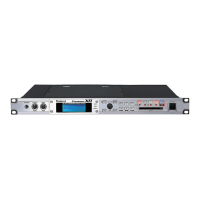49
Creating a Patch
This section explains the functions the different patch parameters
have, as well as the composition of these parameters.
Parameters marked with a “
★
” can be controlled using
specified MIDI messages (Matrix Control). Settings in the
Control screen will determine how these parameters are
controlled (p. 66).
For details on these settings, refer to
“How to Make Patch
Settings”
(p. 46).
Patch General
Patch Category
Specifies the type (category) of the patch.
It also determines the phrase that will be sounded when using the
Phrase Preview function.
For details on the possible category names, refer to p. 41.
Patch Level
Specifies the volume of the patch.
Value:
0–127
Patch Pan
Specifies the pan of the patch. “L64” is far left, “0” is center, and
“63R” is far right.
Value:
L64–0–63R
Patch Priority
This determines how notes will be managed when the maximum
polyphony is exceeded (128 voices).
Value
LAST:
The last-played voices will be given priority, and
currently sounding notes will be turned off in order,
beginning with the first-played note.
LOUDEST:
The voices with the loudest volume will be given
priority, and currently sounding notes will be turned off,
beginning with the lowest-volume voice.
Octave Shift
Adjusts the pitch of the patch’s sound up or down in units of an
octave (+/-3 octaves).
Value:
-3– +3
Patch Coarse Tune
★
Adjusts the pitch of the patch’s sound up or down in semitone steps
(+/-4 octaves).
Value:
-48– +48
Patch Fine Tune
Adjusts the pitch of the patch’s sound up or down in 1-cent steps (+/
-50 cents).
Value:
-50– +50
One cent is 1/100th of a semitone.
Stretch Tune Depth
This setting allows you to apply “stretched tuning” to the patch.
(Stretched tuning is a system by which acoustic pianos are normally
tuned, causing the lower range to be lower and the higher range to be
higher than the mathematical tuning ratios would otherwise dictate.)
With a setting of “OFF,” the patch’s tuning will be equal temperament.
A setting of “3” will produce the greatest difference in the pitch of the
low and high ranges.
Value:
OFF, 1–3
The diagram shows the pitch change relative to equal temperament
that will occur in the low and high ranges. This setting will have a
subtle effect on the way in which chords resonate.
fig.06-011.e
Analog Feel (Analog Feel Depth)
Specifies the depth of 1/f modulation that is to be applied to the
patch. (1/f modulation is a pleasant and naturally-occurring ratio of
modulation that occurs in a babbling brook or rustling wind.)
By adding this “1/f modulation,” you can simulate the natural
instability characteristic of an analog synthesizer.
Value:
0–127
Cutoff Offset
Cutoff Frequency Offset alters the cutoff frequency of the overall patch,
while preserving the relative differences between the cutoff frequency
values set for each tone in the Cutoff Frequency parameters (p. 58).
Range:
-63– +63
This value is added to the cutoff frequency value of a tone, so if the
cutoff frequency value of any tone is already set to “127”
(maximum), positive “+” settings here will not produce any change.
Functions of Patch Parameters
Settings Common to the Entire Patch
(GENERAL)
1
2
3
OFF
2
1
OFF
3
High note range
Pitch difference from
equal temperament
Parameter value
Low note range
Fantom-XR_r_e.book 49 ページ 2006年4月4日 火曜日 午前10時14分

